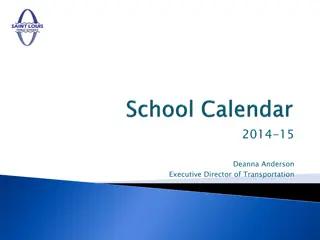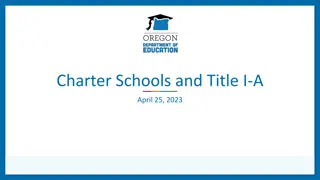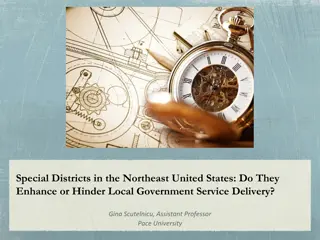Analysis of EL Numbers in Oregon Schools and Districts
This analysis, presented during the HB 3499 ELL Program Advisory Group Meeting, highlights the distribution of Oregon districts and schools based on the number of current English Learners (ELs). It emphasizes the importance of considering EL numbers in identifying low-performing institutions and discusses the challenges posed by very small EL populations. The data reveals how different size categories of districts and schools impact statistical modeling for performance measurement, particularly in relation to the minimum EL threshold. Despite limitations with smaller EL populations, there are considerations for identifying low-performing entities within this group.
Download Presentation

Please find below an Image/Link to download the presentation.
The content on the website is provided AS IS for your information and personal use only. It may not be sold, licensed, or shared on other websites without obtaining consent from the author.If you encounter any issues during the download, it is possible that the publisher has removed the file from their server.
You are allowed to download the files provided on this website for personal or commercial use, subject to the condition that they are used lawfully. All files are the property of their respective owners.
The content on the website is provided AS IS for your information and personal use only. It may not be sold, licensed, or shared on other websites without obtaining consent from the author.
E N D
Presentation Transcript
Distribution of Districts and Schools by Numbers of Current ELs (Based on 2013-14 data) HB 3499 ELL Program Advisory Group Meeting September 22, 2015
Why its Important to Consider EL Numbers The Advisory Group will need to provide guidance re: whether the identification of low-performing institutions should be done at the district level or school level. It is not possible to include districts or schools with very small EL populations in the statistical model that will be used as the primary method to measure district or school performance. The exact minimum threshold for EL size depends on the statistical model selected. ODE used less than 20 Current ELs as the minimum threshold for illustration purposes. We expect the minimum threshold to be close to this estimate.
Distribution of Districts by Numbers of Current ELs (Total Districts with ELs = 139) Distribution of Districts by Numbers of Current ELs (Total Districts with ELs = 139) 50 45 40 35 30 25 44 20 37 34 15 24 10 5 0 Large (500 or more) Medium (100-499) Small (20-99) Too Small? (Less than 20 ELs) Too Small? Refers to the possibility that it will not be possible to include districts with less than 20 total ELs in the proposed statistical model for identifying low-performing districts. Although this category represents 32% of all districts with Current ELs, it also represents less than 1% of the Current EL population in Oregon. We may still be able to identify low-performing districts in this category, just not with the same statistical model used for districts that enroll more ELs.
Distribution of Schools by Numbers of Current ELs (Total Schools with Current ELs = 1070) Distribution of Schools by Numbers of Current ELs (Total Schools with Current ELs = 1070) 600 500 400 300 523 200 100 197 181 169 0 Large (100 or more) Medium (50-99) Small (20-49) Too Small? (Less than 20) Too Small? Refers to the possibility that it will not be possible to include schools with less than 20 total ELs in the proposed statistical model for identifying low-performing schools. Although this category represents almost 50% of all schools with Current ELs, it also represents about 6% of the Current EL population in Oregon. We may still be able to identify low-performing schools in this category, just not with the same statistical model used for schools that enroll more ELs.























